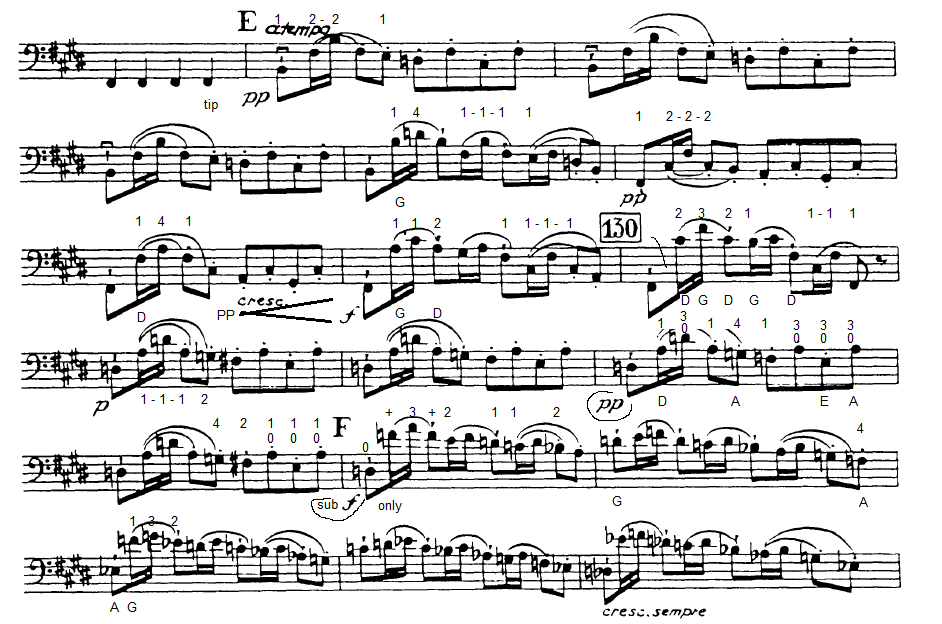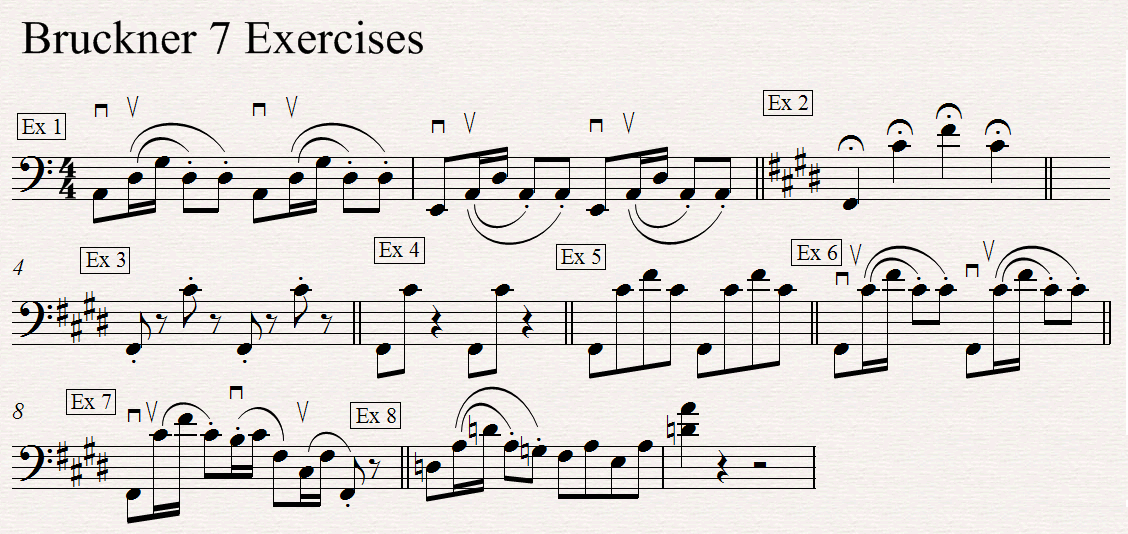Bruckner
symphony no 7, 1st Mov, Fig e


Fig 1 Bruckner 7, 1st mov
Fig E
Bruckner Symphonies are massive structures – huge works for large forces, often
with long passages where the tension is built gradually. The passage above is
one such example, from the first movement of no7, one of the more popular
symphonies
None
This is a tricky passage which tests technique, preparation and
musicality. Specific issues are:-
String crossings – As with many of the excerpts this is a
classic shift vs string crossing dilemma. In many cases the string crossing is
unavoidable – in others there is a choice. I would rather shirt then cross
strings as a rule, for example I use extended fingerings for the min 3rds in
bars 126 and 128. Also I play the maj 3rd in bar 135 thumb + 3. My
fingerings for 143-144 are designed to avoid string crossings – this includes
use of the thumb on E natural in bar 144. There are many instances were string
crossings are unavoidable, so Ex 1 is useful to get the bow close to the target
string (from 2nd to 3rd note, the two semis, eg from F# on the D
string to B on the G string in bar 123)
Bow distribution – it is uneven, and there is a tendancy
to use too much bow in the single quaver at the start of each bar, with the risk
that this note will jump out too loud. This must be avoided by playing this
quaver short and travelling. Ex 1 is good for working on this
Bowing – the string crossings would be easier for lower
strings up-down rather than down-up, but the opposite is true for the upper
strings, and we know who wins this battle in the orchestra!!
Tuning – it is harmonically “interesting” and can be
tricky to keep true pitch in your head. I find it easy to stray sharp in the
last few bars, so need to work with the tuner to keep key notes in tune,
especially from bar 141
Dynamics – as always, its easy to overlook dynamics with
tricky technical passages. The player who demonstrates a full dynamic range
shows they are technically on top of the excerpt. I try to play the pp passages
over the fingerboard and with half the hair. Key points are:-
Bar 128 – huge cresc in last two beats only from pp-f
Bar 131 – not too p as there is a drop to pp coming up in bar 133. My
fingerings use higher positions for the pp, to help make the dynamic change and
to get in position for bar 135
Bar 135 – sub f but not too loud as the passage continues thro ff to fff
at the end
Rhythm – its easy to rush the louder sections, avoid this, keep strictly
in time. Another banana skin in this excerpt are the pairs of semis – it is very
easy to rush them. The tempo is not fast, which makes the risk of rushing even
greater
Nasty sections – the ones that I find need the most work
are:-
bar 130 – this is a shocker. It has the lot, string crossings (the first
two notes are 3 strings apart, the next two are slurred string crossings, the
last 3 are shockers) big shifts, a slurred high 4th. Exercises 2-7
are designed to help get round these problems. The key technical issues are:-
i. keep the first note short, start the shift early so it is less rushed.
This would be much easier on a 5 string bass, as F# could be played on the B
string, avoiding the big shift
ii. I used 3-2 fingering for the C#-F#, the 2nd and 3rd
notes. The hand must be turned so that the fingers are at 45 degrees to the
string, ie pointing down towards the players R foot. This is to avoid the F#
being too sharp, which is a risk with this fingering. There are alternatives,
but a high 4-4 bar is risky and hard to get smooth and there is not enough time
to get the thumb on C# to avoid the string crossing, so I feel my fingering is
the best of a bad lot
bar 134-135 – subito f, the F and A, 2nd and 3rd of
135 are tricky, either as a high string crossing, or to get in position with
thumb on F as I play it. It is often the case that the problem with a passage
that is wrong is not the notes that are wrong but the preparation beforehand. I
find that I stand a better chance of getting my thumb on F for the 2nd
note of bar 135 if my 3rd is stopping an A at the end of the previous
bar. Ex 8 is designed to make this happen. This keeps my L hand in position.
When I play the open D at the start of bar 135, my 3rd is holding an
A, stopping the F with my thumb is likely to interfere with the open D. After
the D, I put my thumb on F, and raise my 3rd finger.
bar 141-end – tricky harmonically, its easy to stray sharp. My fingerings
are designed to avoid string crossings, which will hopefully keep the pairs of
semis in time

How to prepare (long term):-
Chose a starting tempo, say crochet = 66, and work thro the exercises
until they are fixed:-
Ex 1 – get the bow close to the G string in the first bar, before playing
the D. Ditto the D string in the second bar
Ex 2 – practice getting into position to get the C# and F# in tune, which
I check with a chromatic tuner. The key issue is the hand position, with fingers
at 45 degrees to the strings
Ex 3 - 7 – quick shift to the C#, keep the bottom F# short to start the
shift as early as possible
Ex 8 – get the LH on A ready for the open D in bar 135 and more
importantly the thumb on F natural
Play the passage at that tempo
Go back and fix anything that didnt work
Increase metronome marking once the passage is mastered at that tempo, up
to crochet = 92
Work on bar 130 slowly, building it up in tempo
Practice bar 134 for the transition into bar 135, getting into position
for thumb on F nat
LH bars, string crossings, rhythm, shifting, dynamic range, tuning
Extension – closed
Dynamics – scan the part to check, mark to emphasise key changes
Don’t rush semis, especially in f dynamic
Pitch – arrows down at the end to avoid going too sharp
Tempo – arrows back at 135 to avoid rushing, crochet = 92
Rhythm – important to keep in time even where there are tricky string
crossings
Updated 22/4/2012